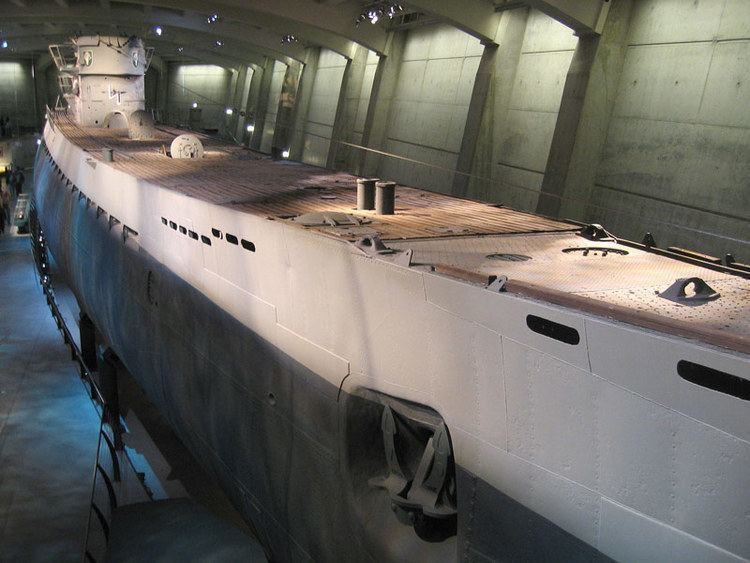Name U-517 Yard number 313 Commissioned 21 March 1942 Launched 30 December 1941 Draft 4.7 m | Ordered 14 February 1940 Laid down 5 June 1941 Construction started 5 June 1941 Length 77 m Beam 6.76 m | |
 | ||
Fate Sunk, November 1942 southwest of Ireland by British carrier aircraft Part of 4th U-boat Flotilla, 10th U-boat Flotilla | ||
German submarine U-517 was a Type IXC U-boat of the Nazi Germany's Kriegsmarine during World War II.
Contents
She was laid down at the Deutsche Werft in Hamburg as yard number 313 on 24 September 1940, launched on 30 December 1941 and commissioned on 21 March 1942 with Kapitänleutnant Paul Hartwig in command.
U-517 began her service career with training as part of the 4th U-boat Flotilla from 21 March 1942. She was reassigned to the 10th flotilla for operations on 1 September.
She carried out two patrols and sank eight ships. She was sunk by British carrier aircraft in November 1942.
Design
German Type IXC submarines were slightly larger than the original Type IXBs. U-517 had a displacement of 1,120 tonnes (1,100 long tons) when at the surface and 1,232 tonnes (1,213 long tons) while submerged. The U-boat had a total length of 76.76 m (251 ft 10 in), a pressure hull length of 58.75 m (192 ft 9 in), a beam of 6.76 m (22 ft 2 in), a height of 9.60 m (31 ft 6 in), and a draught of 4.70 m (15 ft 5 in). The submarine was powered by two MAN M 9 V 40/46 supercharged four-stroke, nine-cylinder diesel engines producing a total of 4,400 metric horsepower (3,240 kW; 4,340 shp) for use while surfaced, two Siemens-Schuckert 2 GU 345/34 double-acting electric motors producing a total of 1,000 shaft horsepower (1,010 PS; 750 kW) for use while submerged. She had two shafts and two 1.92 m (6 ft) propellers. The boat was capable of operating at depths of up to 230 metres (750 ft).
The submarine had a maximum surface speed of 18.3 knots (33.9 km/h; 21.1 mph) and a maximum submerged speed of 7.3 knots (13.5 km/h; 8.4 mph). When submerged, the boat could operate for 63 nautical miles (117 km; 72 mi) at 4 knots (7.4 km/h; 4.6 mph); when surfaced, she could travel 13,450 nautical miles (24,910 km; 15,480 mi) at 10 knots (19 km/h; 12 mph). U-517 was fitted with six 53.3 cm (21 in) torpedo tubes (four fitted at the bow and two at the stern), 22 torpedoes, one 10.5 cm (4.13 in) SK C/32 naval gun, 180 rounds, and a 3.7 cm (1.5 in) as well as a 2 cm (0.79 in) anti-aircraft gun. The boat had a complement of forty-eight.
1st patrol
The boat departed Kiel on 8 August 1942, moved through the North Sea and negotiated the gap between Iceland and the Faroe Islands. She crossed the Atlantic Ocean and attacked Allied shipping in the area of the Gulf of St. Lawrence.
One of her early victims was the Arlyn. This ship had already been torpedoed by U-165. U-517 finished her off on 28 August 1942.
She also sank the Donald Stewart on 3 September 1942 northeast of Cape Whittle. The Canadian escort HMCS Weyburn tried to ram, but the distance between the two vessels was too great. U-517 then evaded a depth charge pattern. A few hours later, she was attacked by a Digby aircraft of No. 10 Squadron RCAF; but the depth charges detonated prematurely, causing more damage to the aircraft than to the U-boat.
The submarine subsequently sank the Canadian corvette HMCS Charlottetown about 5 nautical miles (9.3 km; 5.8 mi) off Cap-Chat on 11 September.
U-517 docked at Lorient in occupied France on 19 October 1942.
2nd patrol and loss
The boat departed Lorient on 17 November 1942 and sailed west. She was hardly out of the Bay of Biscay when she was sunk by Fairey Albacores of 817 Naval Air Squadron from the aircraft carrier HMS Victorious.
One man died; there were 52 survivors.
